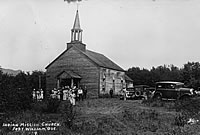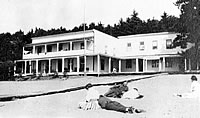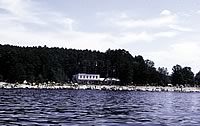Fort William
Click on any image to view a larger image in the photo gallery…

The first inhabitants of the Ottawa Valley were the Anishnabe of the Algonquin Nation. A large part of the Municipality of Sheenboro is situated on the Ottawa River that was a route for First Nations in ancient times and during the fur trade.
Records indicate that the Anishnabe gathered at Lac des Allumettes, a wide part of the Ottawa River across from present-day Petawawa. Consequently, the Hudson’s Bay Company (HBC) sent an apprentice trader in 1821 to Lac des Allumettes in order to intercept the Anishnabe as they came from their hunting grounds and be the first to trade with them. Although there was a small post at Fort Coulonge, the HBC decided to establish a trade post at Lac des Allumettes in 1823. Five years later, additional buildings were added. The Company named this frontier trading post Lac des Allumettes and later Fort William, after William McGillivray, the Managing Director of the Northwest Company. Though the post was a site where large numbers of Algonquins started for their hunting-grounds, the amount of furs did not compensate for the expense of maintaining the establishment. In the 1830s under the tenure of Nicholas Brown, the post added a farm in order to sell provisions to lumber companies for their camps. Lumber camps needed vegetables to feed the shantymen, feed for their horses, and other provisions. The post adjusted its merchandise to serve these camps and local settlers.

By 1844, the Lac des Allumettes Post had taken over most of the trade with the Algonquins of the region. Under the management of Hector McKenzie, the Post was profitable from retail trade with lumber companies and the settlers. Settlers came to the area in the 1830s, some to seek land while many of them worked in lumbering. Some Irish squatters were living around the post and the HBC quickly secured title to the 800 acres of land used for the post’s operations including the farm.
A general store was built in 1845 but burned down in 1852 when a trader was drawing wine to sell to a lumber merchant. Another store was built on the stone foundation. The Chief Trader’s house, still standing today, was built in 1846. The store also served as a post office and when steamboats plied the river, they would stop at the Fort William wharf, bringing people and supplies to the area.

As the Anishnabe traditionally gathered at Fort William, there is a cemetery where some of their people are buried. The HBC also built a small church at Fort William in 1858; both Anishnabe and local people attended this chapel. Initially it was called St. Simions but was renamed St. Theresa of the Little Flower Church. The last large gathering of the Anishnabe at this chapel was in 1885 when 200 of them attended mass officiated by Bishop Narcisse Lorrain from Pembroke. The Post’s trade, church, and burial ground drew the Anishnabe from the rivers that flow into the Ottawa River to this place every summer while they waited for the missionary, an Oblate priest, to come down from James Bay. The missionaries ceased their work at Fort William in 1889. The Diocese of Pembroke assumed responsibility for the chapel while the priest for Sheenboro continued to hold masses in the chapel.

Freight costs, keen competition, and the advent of steam transportation led to Company’s decision to withdraw from the area and close its operations in 1869.
The site was sold to James McCool, who built the Hotel Pontiac in 1896, which became a popular summertime destination. Visitors to the hotel came by steamboat and stayed at this resort hotel that is located on one of the finest beaches on this stretch of the river. At its heyday, the hotel had 60 rooms. Mary Pickford, the darling of silent screen, was a guest of the hotel; Dan Ackroyd, of more recent fame on the screen, also visited the Hotel Pontiac. Although a section of the hotel was torn down, the original structure remains, and meals continue to be served in it.

Every summer on Friday night, fiddle music can be heard from the hotel while music-goers on the porch listen to the tunes and watch the beautiful sunset. Descendants of Mr. McCool remain in the area. Some of them, namely the Miller family, ran the hotel and store for a number of years. Others, including the descendants of Father of Confederation, Thomas D'Arcy McGee, still reside in century cottages beside the hotel.



